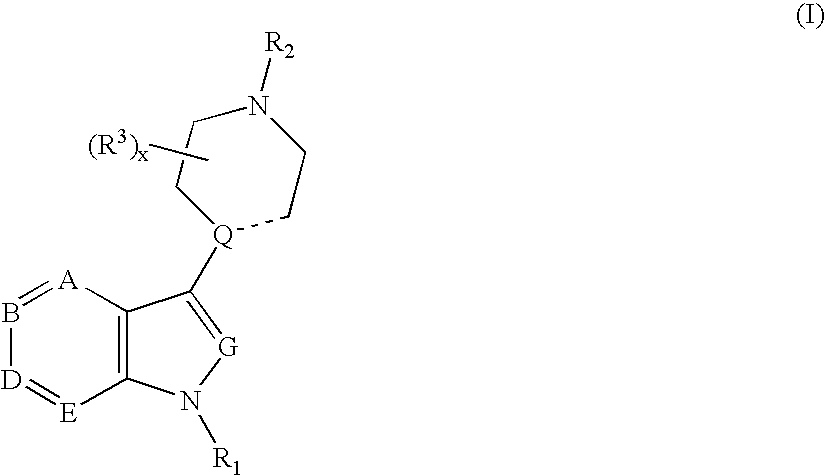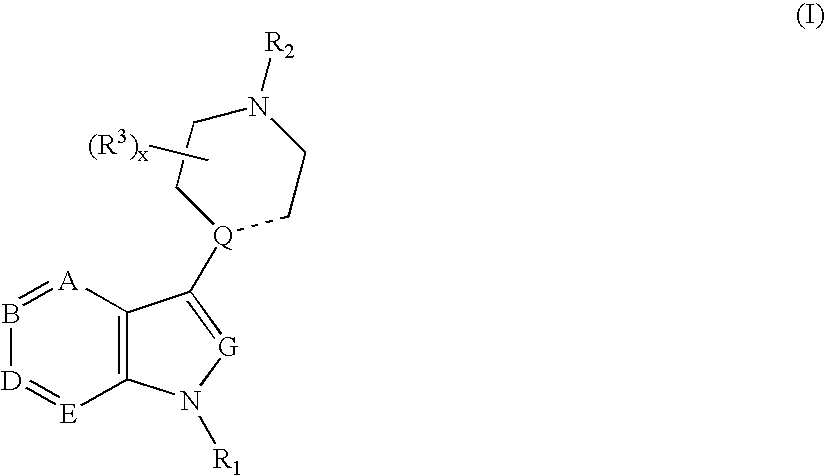Compounds having 5-HT6 receptor affinity
a receptor and affinity technology, applied in the field of compounds, can solve the problems of lack of selective agonists and antagonists, and hinder the in vitro investigation of receptor function
- Summary
- Abstract
- Description
- Claims
- Application Information
AI Technical Summary
Benefits of technology
Problems solved by technology
Method used
Image
Examples
example 1
Synthesis of 1-methylindoline-6-sulfonyl chloride
[1084]
1) Synthesis of 1-methylindoline
[1085]NaH (15 g, 375.00 mmol) was added in several batches to a chilled (0° C.) solution of indoline (30 g, 252.10 mmol) in tetrahydrofuran (400 mL). Methyl iodide (53 g, 373.24 mmol) was then added dropwise with stirring, while maintaining the temperature of 0° C. The resulting solution was stirred at room temperature for 15 hours, then quenched by the addition of ethanol (200 mL). The mixture was concentrated, water (400 mL) was added, and the product was extracted with methylene chloride (3×200 mL). The organics were combined, dried (Na2SO4), filtered and concentrated to provide 20.4 g (60%) of 1-methylindoline as a brown liquid.
2) Synthesis of 1-methylindoline-6-sulfonyl chloride
[1086]ClSO3H (400 g, 3.45 mol) was cooled to 0° C. and 1-methylindoline (35 g, 263.16 mmol) was added dropwise with stirring, maintaining the temperature at 0° C. The resulting solution was then warmed to room temperat...
example 2
Synthesis of 3-(Dimethylamino) benzene-1-sulfonyl chloride
[1087]
[1088]Sulfurochloridic acid (100 g, 862.07 mmol) was cooled to 0° C. and N,N-dimethylbenzenamine (20 g, 165.29 mmol) was added dropwise with stirring, maintaining a temperature of 0° C. The resulting solution was then heated to 120° C. and stirred for 3 hours. After cooling to room temperature, dichloromethane (40 mL) was added and the resulting mixture was added dropwise to 100 mL of ice / salt water. The resulting solution was extracted with dichloromethane (3×500 mL) and the organic layers combined, dried (Na2SO4) and filtered. The filtrate was concentrated and the residue was purified by column chromatography using a 1:100 ethyl acetate / petroleum ether solvent system. The collected fractions were combined and concentrated to give 4.1 g (11%) of 3-(dimethylamino) benzene-1-sulfonyl chloride as a yellow solid. 1H NMR (CDCl3) δ 7.41 (t, 1H), 7.31 (d, 1H), 7.23 (s, 1H), 6.98 (m, 1H), 3.05 (s, 6H).
example 3
Synthesis of 4-morpholinobenzene-1-sulfonyl chloride
[1089]
1) Synthesis of 4-phenylmorpholine
[1090]1-iodobenzene (28.12 g, 137.84 mmol) was added to morpholine (12.0 g, 137.93 mmol). L-Proline (3.12 g, 27.13 mmol) was then added, followed by the addition of CuI (2.6 g, 13.68 mmol) and DMSO (120 mL). The resulting solution was stirred at 90° C. for 4 hours, and then the reaction mixture was then quenched by the addition of 300 mL of iced water. The resulting solution was extracted using dichloromethane (2×200 mL), and the organic layers combined, dried (Na2SO4) and concentrated. The residue was purified by column chromatography using a petroleum ether solvent system. The collected fractions were combined and concentrated to give 10 g (42%) of 4-phenylmorpholine as a white solid.
2) Synthesis of 4-morpholinobenzene-1-sulfonyl chloride
[1091]Sulfurochloridic acid (71.0 g, 612.07 mmol) was cooled to 0° C. and 4-phenylmorpholine (20.0 g, 122.53 mmol) was added in several batches, while keep...
PUM
| Property | Measurement | Unit |
|---|---|---|
| w/w | aaaaa | aaaaa |
| w/w | aaaaa | aaaaa |
| temperature | aaaaa | aaaaa |
Abstract
Description
Claims
Application Information
 Login to View More
Login to View More - R&D
- Intellectual Property
- Life Sciences
- Materials
- Tech Scout
- Unparalleled Data Quality
- Higher Quality Content
- 60% Fewer Hallucinations
Browse by: Latest US Patents, China's latest patents, Technical Efficacy Thesaurus, Application Domain, Technology Topic, Popular Technical Reports.
© 2025 PatSnap. All rights reserved.Legal|Privacy policy|Modern Slavery Act Transparency Statement|Sitemap|About US| Contact US: help@patsnap.com



